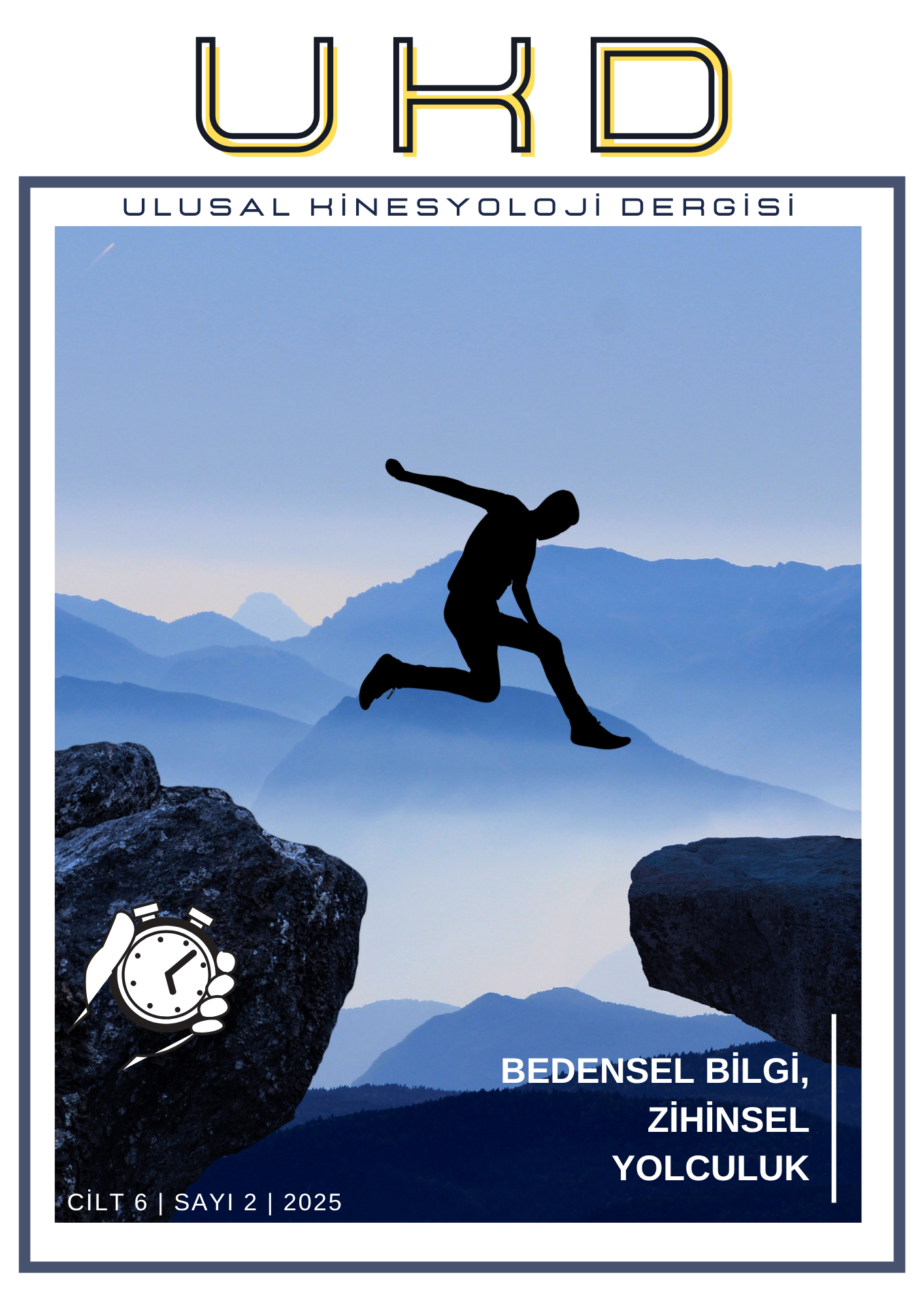Sporcularda kas zorlanmalarını önleme stratejileri: Literatür tabanlı derleme
Anahtar Kelimeler:
Kas- Kas zorlanması- Sporcular- Spor yaralanmalarıÖzet
Kas zorlanmaları, özellikle yüksek yoğunluklu fiziksel aktivite gerektiren sporlarda, sporcuların antrenman ile müsabakalara katılım sürekliliğini ve performansını olumsuz etkileyen, takımlar ve bireylerde maddi ve mental yük oluşturan çok önemli bir klinik sorundur. Bu tür yaralanmalar; kas-tendon ünitesinin aşırı yüklenmesi, yetersiz ısınma, nöromüsküler kontrol bozuklukları, aşırı yüklenme, yetersiz toparlanma ve biyomekanik dengesizlikler gibi çok faktörlü etiyolojik unsurlardan kaynaklanmaktadır. Alınacak önlemler ve yapılacak ölçümler bütüncül bir yaklaşımla uygulandığında, sporcularda kas yaralanmalarının görülme sıklığı belirgin şekilde azaltılabilir. Bu bağlamda, kanıta dayalı uygulamalarla desteklenen koruyucu müdahalelerin yapılandırılması, güncel spor hekimliği ve spor bilimlerinin odak alanlarından biridir. Bu çalışmanın amacı hem bireysel hem takım sporlarında en çok görülen yaralanmalardan olan kas zorlanmalarının daha oluşmadan önüne geçilmesiyle birlikte profesyonel takımlarda ve sporcularda yarattığı mental yük ve yüksek maliyeti önlemeye yardımcı olmaktır.
İndirmeler
Referanslar
Al Attar, W. S., Soomro, N., Sinclair, P. J., & McMaster, T. (2023). Eccentric hamstring training for the prevention of hamstring injuries: a systematic review and meta-analysis. British Journal of Sports Medicine, 57(1), 1-9. https://doi.org/10.1136/bjsports-2022-105445
Bahr, R., & Krosshaug, T. (2005). Understanding injury mechanisms: a key component of preventing injuries in sport. British Journal of Sports Medicine, 39(6), 324–329. https://doi.org/10.1136/bjsm.2005.018341
Chavarro-Nieto, C., Hurtado-Puerto, A., & Villalobos-Carrillo, M. (2023). Influence of strength and flexibility balance on hamstring injury risk in athletes. Journal of Sports Rehabilitation, 32(4), 561-568. https://doi.org/10.1123/jsr.2022-0213
Colebatch, A. N., White, S., & Turner, J. R. (2025). Nutritional strategies to optimize muscle recovery and reduce injury risk in athletes. International Journal of Sport Nutrition and Exercise Metabolism, 35(2), 101-112. https://doi.org/10.1123/ijsnem.2024-0042
Croisier, J.-L., Ganteaume, S., Binet, J., Genty, M., & Ferret, J.-M. (2008). Strength imbalances and prevention of hamstring injury in professional soccer players: a prospective study. The American Journal of Sports Medicine, 36(8), 1469–1475. https://doi.org/10.1177/0363546508316763
Daneshjoo, A., Mokhtar, A. H., Rahnama, N., & Yusof, A. (2013). Effects of the 11+ and Harmoknee Warm-up Programs on Physical Performance Measures in Professional Soccer Players. Journal of Sports Science & Medicine, 12(3), 489-496. https://pmc.ncbi.nlm.nih.gov/articles/PMC3772593/
Danielsson, A., Nordez, A., & de Marés, M. (2020). Hamstring injury incidence and risk factors in athletics: a prospective cohort study. Scandinavian Journal of Medicine & Science in Sports, 30(7), 1352–1360. https://doi.org/10.1111/sms.13682
Devkota, B., & Kayastha, D. (2023). Role of macro- and micronutrients in muscle injury recovery: a review. Nutrition Reviews, 81(4), 324-335. https://doi.org/10.1093/nutrit/nuad012
Ekstrand, J., Hägglund, M., & Waldén, M. (2011). Epidemiology of muscle injuries in professional football (soccer). The American Journal of Sports Medicine, 39(6), 1226–1232. https://doi.org/10.1177/0363546510395879
Gabbett, T. J. (2016). The training-injury prevention paradox: should athletes be training smarter and harder? British Journal of Sports Medicine, 50(5), 273–280. https://doi.org/10.1136/bjsports-2015-095788
Green, B. S., Bourne, M. N., Van Dyk, N., & Timmins, R. G. (2020). Risk factors for hamstring muscle strain injury in sport: a systematic review and meta-analysis. British Journal of Sports Medicine, 54(19), 1184–1191. https://doi.org/10.1136/bjsports-2019-101292
Kürklü, G. B., & Yargıç, M. P. (2020). Injury profile of an elite male football team from the Turkish Super League for two consecutive seasons. Medicina dello Sport, 73(4), 681–688. https://doi.org/10.23736/S0025-7826.20.03701-1
Kürklü, G. B., & Yargıç, M. P. (2021). Kas yaralanmaları sonrası spora dönüş kriterleri. In G. Dönmez (Ed.), Sporcularda kas yaralanmalarına güncel yaklaşım (1. baskı, ss. 114–117). Türkiye Klinikleri. https://www.turkiyeklinikleri.com/article/tr-kas-yaralanmalari-sonrasi-spora-donus-kriterleri-93733.html
Malone, S., Lovell, R., Varley, M. C., & Coutts, A. J. (2018). Unpacking the relationship between training load and injury risk: a critical review of methodological considerations. Sports Medicine, 48(5), 1017–1033. https://doi.org/10.1007/s40279-017-0848-1
Maniar N, Carmichael DS, Hickey JT, et alIncidence and prevalence of hamstring injuries in field-based team sports: a systematic review and meta-analysis of 5952 injuries from over 7 million exposure hoursBritish Journal of Sports Medicine 2023;57:109-116. https://doi.org/10.1136/bjsports-2021-104936
Orchard, J., Seward, H., McGivern, J., & Hood, S. (2013). Intrinsic and extrinsic risk factors for muscle strains in Australian football. The American Journal of Sports Medicine, 31(6), 847-855. https://doi.org/10.1177/03635465030310062201
Petersen, J., Holmich, P., & Thorborg, K. (2011). Preventive exercise program for hamstring injuries in professional football: a cluster-randomized controlled trial. Scandinavian Journal of Medicine & Science in Sports, 21(6), 794-802. https://doi.org/10.1111/j.1600-0838.2010.01190.x
Reis, D. S., de Oliveira, A. S., & de Souza, R. L. (2024). Machine learning methods in sport injury prediction and prevention: a systematic review. Journal of Sports Sciences, 1-15. https://doi.org/10.1080/02640414.2024.1234567
Rudisill, M., Smith, J., & Turner, A. (2023). Effectiveness of warm-up programs in reducing hamstring injury risk: a systematic review. Journal of Athletic Training, 58(3), 223-233. https://doi.org/10.4085/1062-6050-0087.22
Schuermans, J., Van Tiggelen, D., & Witvrouw, E. (2017). Risk factors for hamstring injuries in sports: a systematic review. Sports Medicine, 47(9), 1783–1801. https://doi.org/10.1007/s40279-017-0710-3
Sugiura, Y., Saito, A., & Moriyama, H. (2020). Biomechanical and neuromuscular factors contributing to hamstring injuries in athletes: a review. Journal of Sport and Health Science, 9(1), 1-12. https://doi.org/10.1016/j.jshs.2019.07.005
Timmins, R. G., Bourne, M. N., Shield, A. J., Williams, M. D., Lorenzen, C., & Opar, D. A. (2016). Short biceps femoris fascicles and eccentric knee flexor weakness increase the risk of hamstring injury in elite football (soccer): a prospective cohort study. British Journal of Sports Medicine, 50(24), 1524–1535. https://doi.org/10.1136/bjsports-2015-095362
Turnagöl, H. H., Koşar, Ş. N., Güzel, Y., Aktitiz, S., & Atakan, M. M. (2021). Nutritional Considerations for Injury Prevention and Recovery in Combat Sports. Nutrients, 14(1), 53. https://doi.org/10.3390/nu14010053
Van der Made, A., de Ruiter, C. J., & Jaspers, R. T. (2022). Hamstring injury incidence and recurrence in football: a systematic review and meta-analysis. Sports Medicine, 52(3), 535–545. https://doi.org/10.1007/s40279-021-01568-0
Van Eetvelde, H., Aerts, I., & De Martelaer, K. (2021). GPS and workload monitoring for injury prevention in team sports: a systematic review. International Journal of Sports Physiology and Performance, 16(4), 516-525. https://doi.org/10.1123/ijspp.2020-0495
Vergara-Gutiérrez, L., Lizárraga-Dallo, A., & Pruna-Grive, R. (2020). Nutritional Intervention during Muscle Injury Considering its Pathophysiology: Review Article. Apunts. Educación Física y Deportes, 142, 8-20. https://doi.org/10.5672/apunts.2014-0983.es.(2020/4).142.02
Witvrouw, E., Mahieu, N., Danneels, L., & McNair, P. (2003). Stretching and injury prevention: an obscure relationship. Sports Medicine, 33(7), 511–520. https://doi.org/10.2165/00007256-200333070-00003
İndir
Yayınlanmış
Nasıl Atıf Yapılır
Sayı
Bölüm
Lisans
Telif Hakkı (c) 2025 Galip Bilen Kürklü- Cengiz Güler- Sami Mengütay

Bu çalışma Creative Commons Attribution-NonCommercial 4.0 International License ile lisanslanmıştır.





